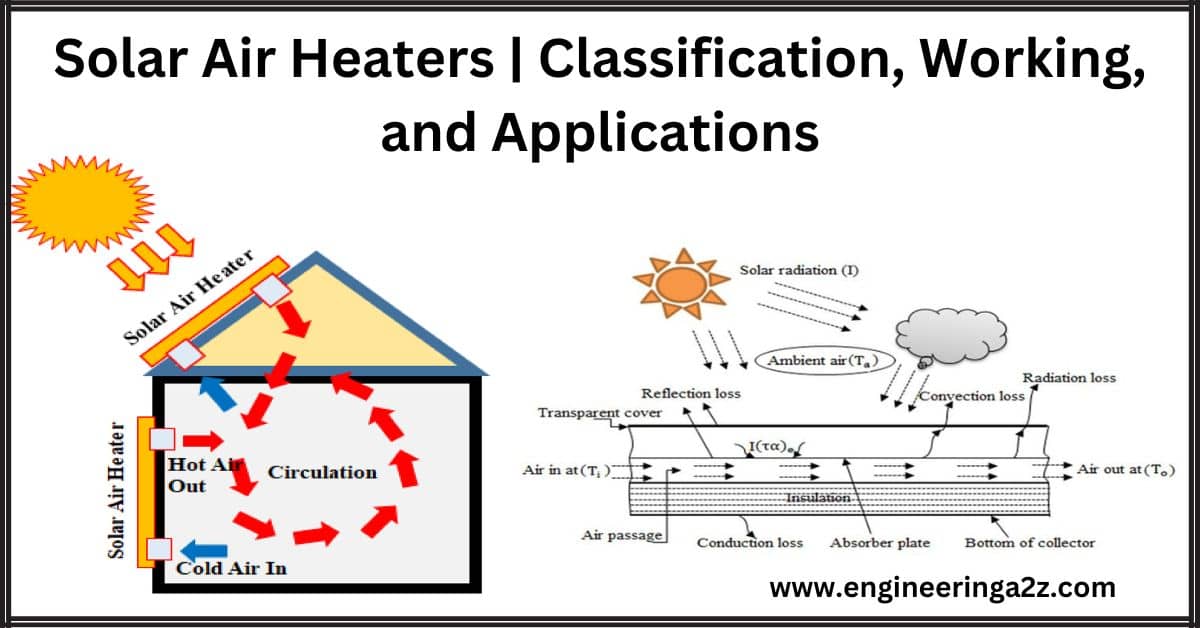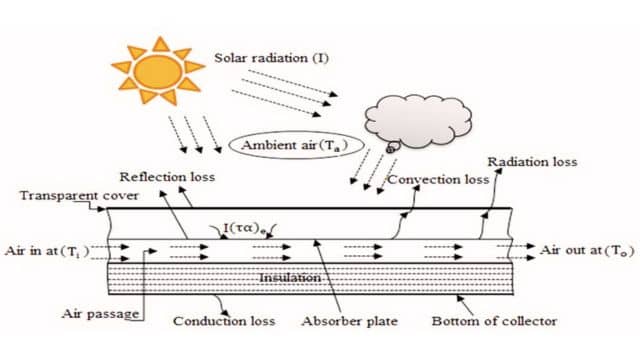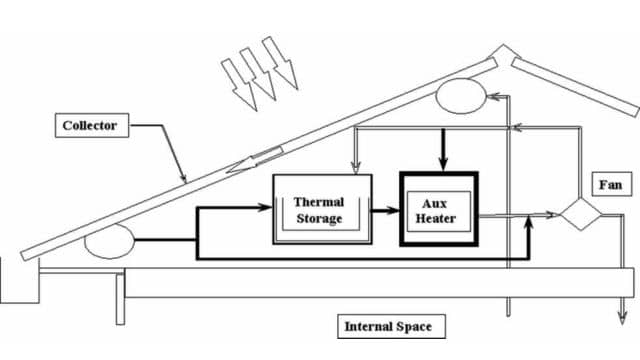
Table of Contents
Solar Air Heaters
A solar air heater is a special solar system that uses sunlight to heat up the air. It has panels that collect the sunlight and make the air warm. This warm air can then be sent directly into a room or stored for later use.
The main parts of a solar air heater are the solar collector panels, a duct system, and diffusers. Some systems have a fan to move the warm air, but others work without a fan using natural airflow.
Solar air heaters are great because they provide free heating inside buildings, working alongside regular heating systems. But they work best when it’s sunny; cloudy days reduce their efficiency. Usually, a solar air heater can heat up a small room nicely. It can be used in any building that needs heating, as long as you can put the collector panels on a sunny, unshaded south-facing roof or wall.
The cost of a solar air heater is around $2500, plus installation. It takes about 10 to 15 years to recover this cost when used with gas heating systems and about five to seven years when used with electricity or wood heating systems. So, it’s an investment that pays off over time and helps save on heating costs.
Classification of Solar Heaters
A conventional solar air heater is like a flat box with specific components inside. It has an absorber plate to collect sunlight, a transparent cover on top, and insulation around it to keep the heat inside. The whole setup is enclosed in a metal container.

The working substance used in this solar air heater is air, and the way the air flows through the heater can differ depending on the type of air heater.
Materials used to build air heaters are similar to those used in liquid flat plate collectors. These materials can let sunlight pass through and absorb it effectively, just like in liquid collectors.
To make the solar air heater even better at capturing sunlight, a special coating called “selective coating” can be applied to the absorber plate. However, we need to make sure this enhancement is cost-effective and doesn’t increase the overall cost too much.
Non-Porous Type Solar Air Heater
In non-porous type solar air heaters, the air does not flow through the space below the absorber plate. Instead, it may flow above and/or behind the plate.
In the first type, the air flows between the transparent cover and the absorber plate directly. However, this design has a drawback because the hot air flowing above the absorber causes the cover to absorb much of the heat, leading to significant heat loss to the surroundings. Due to this inefficiency, this type of air heater is not recommended.
The more commonly used non-porous type with air passage below the absorber has a design where a plate is placed parallel to the absorber plate, creating a passage of high aspect ratio between the absorber and the insulation. This design is more effective in capturing and retaining heat.
In another variety of non-porous type air heaters, the absorber plate is cooled by the air stream flowing on both sides of the plate. This design further enhances the efficiency of the solar air heater.
Porous-Type Solar Air Heater
A porous type solar air heater is a clever device that uses tiny holes or openings in its absorber plate. When sunlight hits the plate, the air flowing through these small holes gets heated up. This heated air is then sent into the area or room that needs to be warmed up. It’s like having a smart and eco-friendly heater that works with the power of the sun. The tiny holes in the absorber plate allow air to pass through and get heated, making it an efficient way to capture solar energy for heating purposes.
These types of solar air heaters are simple to use and can help save on energy costs while being gentle on the environment. With the porous type solar air heater, we can enjoy a cozy and warm space without relying solely on electricity or other traditional heating methods.
Working of Solar Air Heater
Unglazed air collectors are like heaters that use outside air, not the air inside a building. Transpired solar collectors are mounted on walls to catch sunlight from lower angles during winter and even sunlight reflecting off snow. They work best when the air flows through them at rates of 4 to 8 cubic feet per minute per square foot of collector area.

Transpired solar collectors have lots of tiny holes on their surfaces. These holes capture heat from the sun and pull it into an air space behind the panels. This warm air is then taken into the building’s ventilation system through outlets on top of the collector. The warm air is distributed inside the building as needed.
Using transpired solar collectors can cut the need for conventional heating by 10% to 50%. They can also catch heat escaping from the building, bringing it back into the ventilation system. The best part is, they require little maintenance and can last over 30 years.
Advantages of Solar Air Heater
- Solar air heaters use air directly as the working substance, eliminating the need for complicated heat transfer systems.
- Unlike solar water heaters, solar air heaters do not face corrosion problems because they do not involve water.
- Air leakage from the ducts in solar air heaters does not cause significant issues, unlike water leakage in solar water heaters.
- Solar air heaters virtually do not experience freezing problems, as they do not use water-based working fluids like solar water heaters.
- The pressure inside the collector of a solar air heater remains low, allowing for a simpler and more cost-effective design with less material.
- Solar air heaters can be designed using cheaper and lesser amounts of material compared to solar water heaters, making them simpler to use and more economical.
Disadvantages of Solar Air Heater
- Air has relatively poor heat transfer properties, so extra measures are needed to enhance its heat transfer efficiency.
- Air is not very dense, which means that a larger volume of air needs to be processed to achieve significant heating.
- Air cannot store heat well due to its low thermal capacity, making it unsuitable for use as a storage fluid.
- If not designed properly, the cost of solar air heaters can be quite high, making it essential to consider efficient and cost-effective designs.
Applications of Solar Air Heater
- Solar air heaters are a type of solar technology that heats air using sunlight.
- Whether they are useful depends on factors like being really good at capturing sunlight efficiently.
- They should also be affordable to build and install, so many people can use them without spending too much money.
- The cost of running and maintaining them should be low for long-term practicality.
- Engineers have done a lot of research and come up with different designs to improve solar air heaters.
- They have tested these designs on paper and in theory.
- Now, it’s time to make them widely available and put them to use in the real world.
- To do that, we need to make them on a larger scale, so they become easier to find and buy.
- By considering all these factors and working on improving solar air heaters, we can make them a great option for heating our homes and businesses with the power of the sun.
Frequently Asked Questions (FAQs)
What are the three main types of heating?
Three types of heating are conduction, radiation, and convection.
What is the principle of solar air heating?
Solar air heater with glass cover, vee corrugated absorber, and insulated sides. Air flows through the duct and gets heated by the absorber.
What is a solar air heater?
A solar air heater uses sunlight to warm air. It has a glass cover, a vee corrugated absorber sheet with a selective surface, and insulated sides. Air flows through the absorber and gets heated.
What are the main components of solar air heater?
A solar air heater (SAH) has a blackened flat plate absorber, an inlet duct, an outlet duct, insulation to minimize heat loss, and a transparent glass cover to let solar radiation in or trap heat.
Read Also:
- DIAC | Construction | Working and V-I Characteristics
- Tidal Energy | Working, Parts, and Applications
- Solar Furnace | Working Principle, Construction, and Applications
- Stand Alone PV System | Schematics and its Components
- Magnetic Field | Introduction | Effects





Leave a Reply